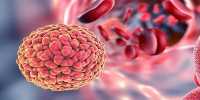Exposure to the heavy metal cadmium is known to irritate the stomach and lungs, as well as cause kidney disease, but new research links another health issue to inadvertently ingesting low doses of the pollutant: high activation of the antibodies that cause an allergic response.
Researchers traced this link in mice to gut bacteria that overproduced an enzyme that degrades vitamin D after being exposed to ingested cadmium, effectively creating conditions that mimic vitamin D deficiency. In terms of clinical effects, mice sensitized to a specific allergen and fed cadmium produced high levels of antibodies against the allergen, as well as immune cells that exacerbated their respiratory symptoms.
Separate epidemiological studies have found a link between vitamin D deficiency and increased susceptibility to asthma and other allergy symptoms in children. In addition, a Congressional report issued on revealed an unexpected source of cadmium in children, revealing that dangerous levels of toxic heavy metals, including cadmium, had been detected in several brands of baby food.
In the paper, we proposed two possible strategies. One option is vitamin D supplementation, but this must occur before cadmium exposure has resulted in a heightened allergic reaction, so the question is when to take a supplement. We also propose that those enzymes be targeted in order to prevent the heightened allergic response.
Professor Prosper Boyaka
“The issue is that because cadmium does not degrade easily – it has a half-life in the body of at least 15 years – if you are chronically exposed to low doses, it accumulates over time,” said Prosper Boyaka, professor and chair of veterinary biosciences at The Ohio State University and senior author of the study. “It’s also not something we can easily avoid because it can persist in the air, soil, and water.”
The majority of people consume the natural element cadmium, a heavy metal used in batteries and pigment production, by eating polluted plant and animal foods or drinking contaminated water. Cadmium is one of eight metals considered extremely toxic at low concentrations by the Environmental Protection Agency.
Boyaka and colleagues discovered that an experimental compound that inhibits the activated enzymes reduced the allergic response in cadmium-fed mice.
“In the paper, we proposed two possible strategies,” Boyaka explained. “One option is vitamin D supplementation, but this must occur before cadmium exposure has resulted in a heightened allergic reaction, so the question is when to take a supplement. We also propose that those enzymes be targeted in order to prevent the heightened allergic response.”
The findings were recently published in the journal Mucosal Immunology.

Environmental pollutants such as cadmium and lead, as well as genetic predisposition and antibiotic overuse, are thought to contribute to the growing number of people with allergies, but the mechanisms underlying that association are not well understood, according to Boyaka.
Researchers added a “subtoxic” dose of cadmium to drinking water consumed by groups of mice for 28 days in this study. The team tested the allergic response of mice to an egg protein using a mouse model that simulates human genetic predisposition to egg allergy.
Mice that drank water containing sub-toxic doses of cadmium and then were exposed to the allergen had a stronger allergic reaction (in the form of internal inflammatory actions and allergy symptoms) than control mice.
“Our hypothesis was that cadmium would alter the microbe population in the gut because we know that dysbiosis, or a change in the microbiota, can cause allergic reactions. And, yes, putting those tiny, tiny doses of cadmium in the drinking water did change allergic sensitization “said Boyaka.
The effect was expected to occur in the gut because germ-free mice, which lack intestinal microbes, were orally exposed to cadmium and did not over-produce the antibody that causes an allergic reaction. However, the researchers discovered that the cadmium was not killing cells or causing the intestines to leak. A series of studies linked cadmium in the gut to the production of inflammatory molecules as well as the activation of two enzymes that degrade vitamin D.
“The main finding is that after sub-toxic doses of heavy metals are exposed, the pollutants remain in soft tissue, including the gut. And what they do is increase the reactivity of cells. Bacteria in the gut, in particular, cause certain cells to produce more of the enzyme that degrades vitamin D “Boyaka stated. “That’s a link we didn’t know about before.”
Boyaka’s lab is currently looking into potential compounds that could be used to inhibit vitamin D-degrading enzymes.
















